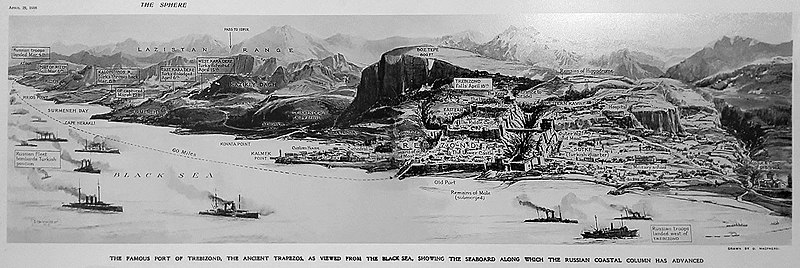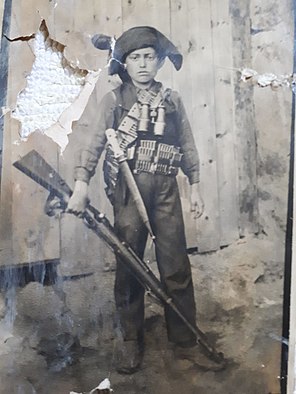| Trebizond Campaign | |||||||||
|---|---|---|---|---|---|---|---|---|---|
| Part of World War I | |||||||||
 The city captured by the Russians | |||||||||
| |||||||||
| Belligerents | |||||||||
|
|
| ||||||||
| Commanders and leaders | |||||||||
|
|
| ||||||||
| Strength | |||||||||
| Russian Caucasus Army | Third Army | ||||||||
| Casualties and losses | |||||||||
| Unknown | Unknown | ||||||||
The Trebizond Campaign, also known as the Battle of Trebizond, was a series of successful Russian naval and land operations that resulted in the capture of Trabzon. It was the logistical step after the Erzerum Campaign. Operations began on February 5 and concluded when the Ottoman troops abandoned Trabzon on the night of April 15, 1916.
Lazistan offensive
Timeline
- 1916
- 2nd half of January; Russians occupied the territory between the coruh and the Russian frontier. Makriali was taken.
- January 17–20; Russian destroyers crushed a large number of Turkish sailing craft along Lazistan coast that were supplying Turkish army.
- February; Turkistanski Regiments occupied Hopa.
- February 5; Russian squadron heavily damaged Turkish trenches beyond the Arhavi river.
- February 6: Turks abandoned their lines, leaving 500 dead behind.
- February 15–16: The same sequence of events was repeated at Vitze. Turks retrenched behind the Buyuk-dere river. Several Turkish battalions reinforced Rize from Trebizond. General Lyakhov in conference with naval officers accepted proposal to land infantry (2 battalions with 2 mountain guns) in the rear of the Turkish position.
- March 4–5; Rostislav and the gunboats Kubanetz and Donetz supported the amphibious landing at Atina. Turks on the Buyuk-dere position fled into the mountains.
- March 6–7; the landing operation was repeated at Mapavri and met with only slight resistance.
- March 8; Russians occupied Rize and pushed their patrols forward to the river Kalapotamos to the east of the small town of Of. Here the advance of the Black Sea coast detachment was temporarily halted.

Effect on Armenians
Prior to World War I, the vibrant Armenian community of Trabzon numbered 30,000. In 1915, during the Armenian genocide, they were massacred and deported. After the Russian capture of Trabzon, some 500 surviving Armenians were able to return, as well as Armenian monks of the Kaymakli Monastery.

References

- Walton, Robert (1984). The Capture of Trabzon. Marshall Cavendish Illustrated Encyclopedia of World War I, vol iv. New York: Marshall Cavendish Corporation. pp. 1306–1313. ISBN 0-86307-181-3.
- Weir, Gary E.; Halpern, Paul G. (February 1996). "A Naval History of World War I.". The American Historical Review. 101 (1): 157. doi:10.2307/2169242. ISSN 0002-8762. JSTOR 2169242.
- Willmott, p. 305.
- ^ (in Armenian) Soviet Armenian Encyclopedia, Trapizon, Vol. 12, Yerevan 1986. p. 87
- The Byzantine Churches of Trebizond, Selina Ballance, Anatolian Studies, volume 10, page 169.
| Trabzon | |
|---|---|
| Landmarks | |
| Transport | |
| Education | |
| History | |
| This list is incomplete. | |